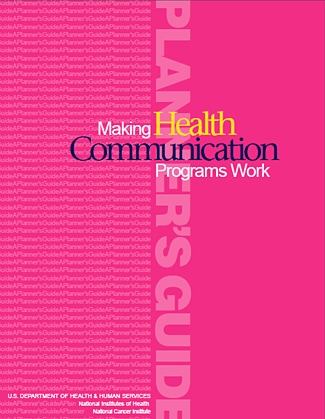Getting Started
Understand Your Audience: Older Adults: Contents
Planning Your Project

For dissemination, think about where and how your older adult audience will read or hear your message.
Creating a clear and concise message requires a carefully thought-out plan. Whether you have a few days or a few months to design your communication product, you can follow these simple steps to help you think through the design process.
- Identify your audience – You’ve been charged with designing a communication product for older adults, but which group of older adults? Does your population of focus have a specific health condition? Are you designing messaging for a specific ethnic group? Does your audience reside in a particular geographical area? Knowing the answers to these questions will help you design your product and identify individuals who can test your product.
- Identify your partners – Are you working on the project alone or are you working with a team? Your collaborators might include program staff, writers, editors, graphic designers, reviewers, Area Agencies on Aging, senior community centers, and senior community leaders. Each partner should contribute to the project in some way. For example, staff at a senior community center can help identify individuals who can test your product.

For more information on health communication planning and evaluation, see NIH National Cancer Institute's Making Health Communication Programs Work [PDF 4.05MB].
Develop a workplan – Before you jump in, think about the deadline for your project. What are the specific steps you need to take to get the job done? Assign roles for each task. Here are some questions you may want to think about:
- What is your timeline?
- What resources do you have?
- What is your budget?
- Who will write, edit, and review your draft?
Hint: Make a table of specific tasks and assign end dates for each task.For more information on health communication planning and evaluation, see NIH National Cancer Institute’s Making Health Communication Programs Work [PDF 4.05MB].
- Set objectives – Think about the needs and wishes of your older adult population. What is the most important information that they need to know? Consider prioritizing messages. Also, think about the goals and objectives of your collaborators. How do their goals align with the needs of your intended audience?
- Develop a dissemination and evaluation plan – Develop your dissemination and evaluation strategy during the planning phase. For dissemination, think about where and how your older adult audience will read or hear your message. How can you ensure that you reach as many people as possible?
Get feedback from your audience during the testing process and collaborate with your partners to generate ideas. For example, if you want to create fall-prevention materials for a senior living community and you find that the residents like receiving health information in the mail, you could coordinate with management and deliver your materials to each resident’s mailbox. As an added step, you could also place your materials in the residential office or on the community board.Your evaluation plan should align with your goals and objectives. Make sure you’re measuring meaningful aspects of the project. For example, if your outcome evaluation goals for the fall-prevention project are to raise awareness of fall risks and increase fall-prevention behavior in the senior living community, you might measure the following:
- The number of materials handed out through the office (awareness)
- The number of residents who recall your educational materials (awareness)
- The increase in the number of people taking fall-prevention precautions (behavior)
- The number of residents who say it is important to prevent falls (attitudes)